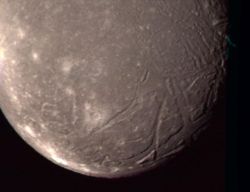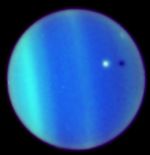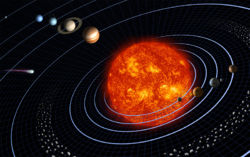Ariel
 From Conservapedia
From Conservapedia - This article is about the moon of Uranus. For other uses, see Ariel (disambiguation).
| Ariel | |
|---|---|
 High-resolution color image of Ariel, taken by Voyager 2 | |
| Date of discovery | October 24, 1851[1][2][3] |
| Name of discoverer | William Lassell[1][2][3][4] |
| Name origin | A sylph in The Rape of the Lock by Alexander Pope;[1][5] a sprite in The Tempest by William Shakespeare[6] |
| Orbital characteristics | |
| Primary | Uranus |
| Order from primary | 15 |
| Periuranion | 184,525 km[7] |
| Apuranion | 197,515 km[7] |
| Semi-major axis | 191,020 km[8] |
| Orbital eccentricity | 0.0034[8] |
| Sidereal month | 2.520379 da[8] |
| Avg. orbital speed | 5.52 km/s[4] |
| Inclination | 0.31°[4][8] to Uranus's equator |
| Rotational characteristics | |
| Sidereal day | 2.520379 da[4][8] |
| Rotational speed | 16.7 m/s[7] |
| Axial tilt | 0°[8] |
| Physical characteristics | |
| Mass | 1.35 * 1021 kg[8] |
| Density | 1,670 kg/m³[8] |
| Mean radius | 578.9 km[4] |
| Surface gravity | 0.27 m/s²[7] |
| Escape speed | 0.541 km/s[4] |
| Surface area | 4,211,310 km²[7] |
| Mean temperature | 58 K[9] |
| Composition | Water ice and rock[10] |
| Color | Deep gray-purple |
| Albedo | 0.34[4] |
Contents
- 1 Discovery and naming
- 2 Orbital characteristics
- 2.1 Transits of Uranus
- 3 Rotational characteristics
- 4 Physical characteristics
- 4.1 Surface
- 5 Problems for uniformitarian theories
- 6 Observation and Exploration
- 7 References
Discovery and naming[edit]
William Lassell discovered Ariel and its next companion, Umbriel, on October 24, 1851, and reported his findings after observing these two satellites on three more occasions.[2][3]
The name Ariel, suggested by Sir John Herschel at Lassell's request, is the name of a sylph in Alexander Pope's poem The Rape of the Lock.[5] It is also the name of a sprite and servant to Prospero in William Shakespeare's play The Tempest.[6]
Orbital characteristics[edit]
Ariel is in a slightly eccentric orbit around Uranus at an average distance of 191,020 km. Its sidereal month is about 2.52 Earth days. The orbit of Ariel is only slightly inclined from the equator of Uranus but is severely inclined to the ecliptic.
Tittemore[9] suggests that Ariel was once in a 4:1 orbital resonance with Titania. If it was, it is no longer in such a resonance. For this reason, some astronomers suggest that Ariel was much hotter in the past than it is today.[6]
Transits of Uranus[edit]

Ariel is rarely able to transit the surface of Uranus in such a manner as to cast a shadow on it. This is because Ariel, like all the moons of Uranus, is in an orbit with an almost perpendicular inclination to the ecliptic. Such transits usually occur only in years close to Uranian equinoxes. One such transit occurred on July 26, 2006; the Hubble Space Telescope captured that transit on the image at the left. The white dot in the upper-right-hand quadrant of Uranus is Ariel itself; the black dot is its shadow.[11]
Rotational characteristics[edit]
Ariel is in tidal lock with Uranus.
Physical characteristics[edit]
Ariel is composed of rock and water ice. Some authorities suggest that Ariel might also contain ices of ammonia, methane, or carbon monoxide.[4]
Surface[edit]
The surface of Ariel has relatively few impact craters, and also a system of interconnecting valleys and rifts.[4][6] Some of these valleys bear signs of smoothing by a fluid. Liquid water would not smooth the valley floors in this fashion, and for this reason astronomers suspect that the fluid might have been liquid ammonia or methane. Other valleys and canyons appear to have formed by faulting.
Most of the surface of Ariel appears relatively "young" by uniformitarian standards. In fact, some authorities say that Ariel's surface is the youngest such surface among the major moons of Uranus.[10]
Problems for uniformitarian theories[edit]
Ariel poses the same problem for uniformitarian astronomy as do all the other moons of Uranus: its orbit is inclined severely to the ecliptic, though not to Uranus' own equator. How the Uranian system came to have such an inclination has never been explained.
Observation and Exploration[edit]
Ariel is visible from Earth with any telescope having an aperture of 30 cm or more.
The one spacecraft to visit Ariel was Voyager 2. Voyager approached to within 127,000 km of Ariel on January 24, 1986, and took several images.[12][13]
Today the Hubble Space Telescope is the most powerful telescope to take images of Ariel.
References[edit]
- ↑ 1.0 1.1 1.2 "Gazetteer of Planetary Nomenclature: Planetary Body Names and Discoverers." US Geological Survey, Jennifer Blue, ed. March 31, 2008. Accessed April 17, 2008.
- ↑ 2.0 2.1 2.2 Lassell, W. "Letter to the Editor re Discovery of Two Satellites of Uranus." Astron. J. 2:70, 1851. Accessed June 13, 2008.
- ↑ 3.0 3.1 3.2 Lassell, William. "Entdeckung von 2 neuen Uranus Trabanten." Astronomische Nachrichten, 33:259-260, 1852. Accessed June 13, 2008
- ↑ 4.0 4.1 4.2 4.3 4.4 4.5 4.6 4.7 4.8 Hamilton, Calvin J. "Entry for Ariel." Views of the Solar System, 2001. Accessed June 13, 2008.
- ↑ 5.0 5.1 Lassell, William. "Beobachtungen der Uranus-Satelliten." Astronomische Nachrichten 34:325-328, 1852. Accessed June 12, 2008.
- ↑ 6.0 6.1 6.2 6.3 Arnett, Bill. "Entry for Ariel." The
Nine8 Planets, December 11, 2004. Accessed June 13, 2008. - ↑ 7.0 7.1 7.2 7.3 7.4 Calculated
- ↑ 8.0 8.1 8.2 8.3 8.4 8.5 8.6 8.7 Williams, David R. "Uranian Satellite Fact Sheet." National Space Science Data Center, NASA, November 23, 2007. Accessed June 13, 2008.
- ↑ 9.0 9.1 Tittemore, William C. "Tidal Heating of Ariel." Icarus 87:110-139, September 1990. doi:10.1016/0019-1035(90)90024-4 Accessed June 13, 2008.
- ↑ 10.0 10.1 Ingersoll, Andrew P. "Ariel." Encyclopædia Britannica. 2008. Encyclopædia Britannica Online. 13 June 2008.
- ↑ "Hubble Captures a Rare Eclipse on Uranus." News Release STScI-2006-42, August 31, 2006. Accessed June 13, 2008.
- ↑ "Voyager Mission Description: Voyager 2 Uranus Encounter." February 19, 1997. Accessed June 13, 2008.
- ↑ Smith, B.A., Soderblom, L.A., Beebe, R., et al. "Voyager 2 in the Uranian system - Imaging science results." Science 233:43-64, July 4, 1986. Accessed June 13, 2008.
| |||||||||||||||||||||||||||||
Categories: [Astronomy]
↧ Download as ZWI file | Last modified: 03/13/2023 15:36:14 | 47 views
☰ Source: https://www.conservapedia.com/Ariel | License: CC BY-SA 3.0
 ZWI signed:
ZWI signed:
 KSF
KSF